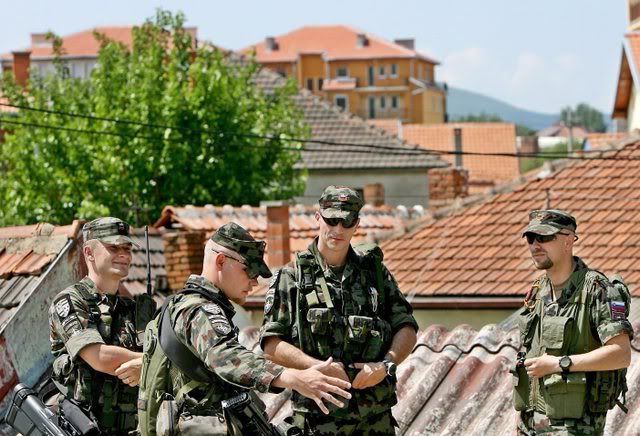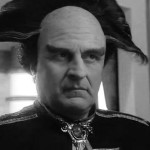
Ratko Mladić
I didn't know we employed war criminals.
Even his name says it: RATko
I hear Srbija is offering 1 million euros (tax-free!) to anyone with information leading to his arrest. Maybe it's time to go bounty hunting.

The Serbs don't seem to like it that much though:
According to the latest poll of the NGO Strategic Marketing for the TV Station B92, 14.29% of Serbia's citizens would reveal information that would lead to his arrest in exchange for €1 million, 20.57% do not have a determined attitude, and 65.14% would not exclude information for one million Euros
Honor more important than money?
Slovenians look like they know how to fight.
Yeah, watch The Death of Yugoslavia to see how we defeated the mighty Serbs in 10 days:
 viewtopic.php?f=65&t=102757http://en.wikipedia.org/wiki/10_day_war
viewtopic.php?f=65&t=102757http://en.wikipedia.org/wiki/10_day_warFollowing the death of Yugoslav president Josip Broz Tito in 1980, underlying political, ethnic, religious, and economic tensions within Yugoslavia came to the surface.
In 1989 Slobodan Milošević, Chairman of the Central Committee of the League of Communists of Serbia since 1986, became president of Serbia, the largest and most populous of the six Yugoslav republics. In April 1990, Slovenia held its first democratic multi-party elections, won by the DEMOS coalition.
Preparations for war
On 23 December 1990, Slovenia held a referendum on independence which passed with 88% of the vote. The Slovenian government was well aware that the federal government in Belgrade might seek to use military force to rein in Slovenia's moves towards independence. Immediately after the Slovenian elections, the Yugoslav People's Army (JNA) announced that a new defence doctrine would apply across the country. The Tito-era doctrine of "General People's Defence", in which each republic maintained a Territorial Defence Force (Teritorialna obramba or TO), would henceforth be replaced by a centrally-directed system of defence. The republics would lose their role in defence matters and their TOs would be disarmed and subordinated to JNA headquarters in Belgrade.
The Slovenian government resisted these moves, successfully ensuring that the majority of Slovenian TO equipment was kept out of the hands of the JNA. It also declared in a constitutional amendment passed on 28 September 1990 that its TO would be under the sole command of the Slovenian government. At the same time, the Slovenian government set up a secret alternative command structure, known as the Manoeuvre Structures of National Protection (Manevrska struktura narodne zaÅ¡Äite, or MSNZ). This was an existing but antiquated institution, unique to Slovenia, which was intended to enable the republic to form an ad hoc defence structure, akin to a Home Guard. It was of negligible importance prior to 1990, with antiquated weapons and few members. However, the DEMOS-led government realised that the MSNZ could be adapted to provide a parallel organisation to the TO that would be entirely in the hands of the Slovenian government.
When the JNA tried to take control of the Slovenian TO, the TO's command structure was simply replaced by that of the parallel MSNZ. Between May and October 1990, some 21,000 TO and police personnel were secretly mobilised into the MSNZ command structure, of which the federal government was wholly unaware. The Slovenian government also undertook detailed planning of a military campaign against the JNA, which resulted in the production of an operational and tactical plan by November 1990 — over seven months before the conflict actually began.[1]
The Slovenes were well aware that they would not be able to resist the JNA for a very long time. Under Defence Minister Janez Janša, they adopted a strategy based on an asymmetric warfare approach. TO units would carry out a guerrilla campaign, using anti-tank weapons and anti-aircraft missiles to ambush JNA units. Tank columns could be trapped by destroying the lead and rear vehicles in favourable terrain — for instance, on a narrow mountain road where room for manoeuvre was limited – enabling the rest to be tackled more easily. In preparation for this, the Slovenian government covertly bought lightweight missile systems from foreign suppliers, notably the SA-7 Grail (Strela) anti-aircraft missile and the German-designed Armbrust anti-tank system. Hit-and-run and delaying tactics were to be preferred and frontal clashes were to be avoided since in such situations the JNA's superior firepower would have been very difficult to overcome.
On the diplomatic front, neither the European Community nor the United States were willing to recognise the independence of Slovenia and strongly advocated the continuation of a unified Yugoslavia. The Slovenian government sought international assistance in negotiating a peaceful breakup of Yugoslavia but was rebuffed by Western countries that said they preferred to deal with a single federation rather than numerous small states. (FUCKS!!!) However, the Slovenes contended that they had no choice in pushing for independence, given a perceived lack of commitment to democratic values on the part of the Belgrade authorities.
Slovenia unexpectedly declared independence on 25 June 1991 (it had previously announced that it would do so on 26 June). This "advance" on the date of independence was a critical element of the Slovenian plan to gain an early advantage in the expected conflict. The Slovenian government fully expected the Yugoslav military to respond with force on the day of the declaration of independence or shortly afterwards. By secretly advancing the date by 24 hours, the Slovenians wrongfooted the Yugoslav government, which had set 26 June as the date for its move.[2]
Although the Yugoslav army was adamantly opposed to Slovenian independence, it was divided about what to do. The JNA Chief of Staff, Colonel-General Blagoje Adžić, advocated a large-scale military operation to remove the Slovenian government and bring "healthy forces" to power in the republic. His political superior, the Yugoslav Defence Minister General of the Army Veljko Kadijević, insisted on a more cautious approach – essentially a show of force that would convince the Slovenian government to back down on its declaration of independence. After some debate, Kadijević got his way.[3]
It is unclear how much the civilian members of the Yugoslav government were involved in the decision to resort to force in Slovenia. Ante Marković, the President of the Federal Executive Council (equivalent to Prime Minister) is reported to have said that the federal government had not been informed of the Army's actions.[4]
26 June 1991
On the morning of 26 June, units of the Yugoslav People's Army's 13th Corps left their barracks in Rijeka, Croatia, to move towards Slovenia's borders with Italy. The move immediately led to a strong reaction from local Slovenes, who organised spontaneous barricades and demonstrations against the JNA's actions. There was, as yet, no fighting, and both sides appeared to have an unofficial policy of not being the first to open fire.
By this time, the Slovenian government had already put into action its plan to seize control of the republic's border posts and the international airport at Brnik. The personnel manning the border posts were, in most cases, already Slovenians, so the Slovene take-over mostly simply amounted to changing of uniforms and insignia, without any fighting. This was undertaken, in the words of Janez Janša, to "establish our sovereignty in the key triangle, border-customs-air control."[5] It also had important practical effects. The border crossings were a major source of revenue. In addition, by taking control of the borders, the Slovenians were able to establish defensive positions against an expected JNA attack. This meant that the JNA would have to fire the first shots.
27 June 1991
Further JNA troop movements took place in the early hours of 27 June. A unit of the JNA's 306th Anti-Aircraft Regiment, based in Karlovac, Croatia, crossed the Slovenian border at Metlika. A few hours later, a column of tanks and armoured personnel carriers of the JNA 1st Armoured Brigade left their barracks at Vrhnika near the Slovenian capital Ljubljana, heading for the airport at Brnik. They arrived a few hours later and took control of the facilities. It is worth mentioning here that as the JNA was the federal army, its forces were placed in various places within the federal republics including Slovenia. To the east, JNA units left Maribor heading for the nearby border crossing at Å entilj and the border town of Dravograd further west. The Yugoslav Air Force aircraft dropped leaflets over various parts of Slovenia bearing the somewhat contradictory messages "We invite you to peace and cooperation!" and "All resistance will be crushed."[6]
In the early hours of 27 June the Slovenian leadership was told of the movements of the JNA. The military leadership of the Fifth Military District, which included Slovenia, was in telephone contact with Slovenian president Milan KuÄan, telling him that the troops' mission was limited to taking over the border crossings and airport. A meeting of the Slovene presidency was hastily convened at which KuÄan and the rest of the members decided on armed resistance.[7]
The Slovenian government had received warnings that the JNA would use helicopters to ferry special forces troops to strategic locations. It issued a warning to the JNA's 5th Military Command District in Zagreb that if helicopters continued to be used they would be shot down. The warning was disregarded by the JNA leadership, which still believed that the Slovenians would back down rather than fight. This was, however, a disastrous miscalculation. In the afternoon of 27 June, the Slovenian TO shot down two JNA helicopters over Ljubljana, killing the occupants (one of whom was a Slovenian pilot, as JNA's forces consisted of nationals from all the republics).
The TO also took up position around JNA barracks in various locations, effectively besieging them, and launched a series of attacks on JNA forces across Slovenia. At Brnik, a TO unit attacked the JNA troops holding the airport, and at Trzin a firefight developed in which four JNA soldiers and one TO soldier were killed and the remainder of the JNA unit was forced to surrender. Attacks were also launched by Slovenian TO units on JNA tank columns at Pesnica, Ormož and Koseze, near Ilirska Bistrica. A tank column from the JNA's 32nd Mechanised Brigade, advancing from Varaždin in Croatia, was blocked at Ormož near the Slovenian border and found itself unable to break through a Slovenian barricade.
Despite the confusion and fighting, the JNA nonetheless successfully accomplished much of its military mission. By midnight on 27 June it had captured all of the crossings along the Italian border, all but three crossings on the Austrian border and several of the new crossing points established along Slovenia's border with Croatia. However, many of its units were still stuck in vulnerable positions across Slovenia.
28 June 1991
During the night of 27–28 June, Slovenian TO units were ordered to undertake a general offensive against the JNA. The Slovenian defence ministry ordered:
At all locations where RS [Republic of Slovenia] armed forces have the tactical advantage, offensive actions against enemy units and facilities will be carried out. The enemy will be summoned to surrender, the shortest deadline possible for surrender given and action taken using all available weapons. While in action, the necessary arrangements will be made to evacuate and protect the civilians.
Further fighting took place throughout the day. The JNA tank column that had been attacked at Pesnica the previous day was blocked by impromptu barricades of Slovenian trucks at Strihovec, a few miles short of the border with Austria, where it again came under attack by TO personnel and Slovenian police. The SFR Yugoslav Air Force mounted two attacks in support of the JNA forces at Strihovec, killing four truck drivers. At Medvedjek in central Slovenia, another JNA tank column came under attack at a truck barricade, where air raids killed six truck drivers. Heavy fighting broke out at Nova Gorica on the border with Italy, where the Slovenian Special Forces destroyed three JNA T-55 tanks and captured three more. Four JNA soldiers were killed and nearly 100 more surrendered.
The border crossing at Holmec was captured by Slovenian forces, with two fatalities on the Slovenian side and three on the JNA side; 91 JNA soldiers were captured. The JNA barracks at Bukovje near Dravograd were attacked by TO units and a JNA weapons depot at Borovnica fell to the Slovenian TO, significantly improving the Slovenians' supply of weapons. The Yugoslav Air Force carried out attacks at a number of locations across the country, most notably at Brnik Airport, where two Austrian journalists were killed and four Adria Airways airliners were seriously damaged. The Air Force also attacked the Slovenian military headquarters at KoÄevska Reka and flew sorties against radio and television transmitters at Krim, Kum, Trdinov vrh and Nanos in an attempt to silence the Slovenian government's broadcasts.
By the end of the day, the JNA still held many of its positions but was rapidly losing ground. It was already beginning to suffer problems with desertions — many Slovenian members of the JNA quit their units or simply changed sides - and both the troops on the ground and the leadership in Belgrade appeared to have little idea of what to do next.
29 June 1991
The outbreak of the war galvanised diplomatic efforts by the European Community to find an end to the crisis. Three EC foreign ministers met with Slovenian and Yugoslav government representatives in Zagreb during the night of 28 June-29 June and agreed on a ceasefire plan, but this was not put into practice. In the morning, the Slovenes achieved several significant military successes. The JNA troops at Brnik Airport surrendered to Slovenian TO forces, who had surrounded the facility overnight. In the north, several JNA tanks were captured near Strihovec and later reorganised into a TO tank company. JNA special forces attempted a maritime landing at Hrvatini but were ambushed and repulsed by the Slovenians. The JNA-held border crossings at Vrtojba and Å entilj also fell to the Slovenians, who seized the federal troops' weapons and tanks, providing a much-needed boost to their arsenal.
The JNA issued an ultimatum to Slovenia, demanding an immediate cessation of hostilities by 0900 on 30 June. In response, the Slovenian Assembly adopted a resolution calling for a peaceful solution to the crisis that did not jeopardise Slovenian independence, and rejected the JNA ultimatum.
30 June 1991
Skirmishing continued in several places during the day. Slovenian forces captured the strategic Karawanken Tunnel under the Alps on the border with Austria and captured nine JNA tanks near Nova Gorica. The entire JNA garrison at Dravograd - 16 officers and 400 men, plus equipment — surrendered, and the garrisons at Tolmin and Bovec also fell to the Slovenians. The weapons captured from the garrisons were quickly redistributed to the Slovenian forces.
1 July 1991
More skirmishes took place, with Slovenian forces capturing a JNA facility at Nova Vas, south of Ljubljana. The JNA's ammunition dump at ÄŒrni Vrh caught fire and was destroyed in a massive explosion, damaging much of the town. However, the Slovenians successfully captured depots at PeÄovnik, Bukovžlak and ZaloÅ¡ka Gorica, taking possession of some 70 truckloads of ammunition and explosives.
The JNA 306th Light Air Defence Artillery Regiment's column retreated from its exposed position at Medvedjek and headed into the Krakovski forest (Krakovski gozd) near the Croatian border. It ran into a blockade near the town of Krško and was surrounded by Slovenian forces, but refused to surrender, probably hoping for help from a relief column.
In the meantime, the JNA's leadership sought permission to change the tempo of its operations. Defence Minister Veljko Kadijević informed the Yugoslav cabinet that the JNA's first plan - a limited operation to secure Slovenia's border crossings had failed, and that it was time to put into operation the backup plan of a full-scale invasion and imposition of military rule in Slovenia. However, the cabinet — headed at the time by Serbia's Borisav Jović — refused to authorise such an operation. The JNA Chief of Staff, General Blagoje Adzić, was furious and publicly denounced "the federal organs [which] continually hampered us, demanding negotiations while they [the Slovenians] were attacking us with all means."[8]
2 July 1991
The heaviest fighting of the war to date took place during 2 July, which proved a day of disasters for the JNA. The JNA tank column in the Krakovski forest came under sustained attack from TO units, forcing it to surrender. Units from the JNA's Fourth Armoured Corps attempted to move up from Jastrebarsko in Croatia but were beaten back near the border town of Bregana. The Slovenian TO mounted successful attacks on border crossings at Å entilj, Gornja Radgona, FernetiÄi and Gorjansko, capturing them and taking a number of JNA troops prisoner. A lengthy engagement between JNA and TO forces took place during the afternoon and evening at Dravograd, and a number of JNA facilities around the country fell to Slovenian forces.
At 2100, the Slovenian Presidency announced a unilateral ceasefire. However, this was rejected by the JNA leadership, which vowed to "take control" and crush Slovenian resistance.
3 July 1991
A large JNA armoured convoy set off from Belgrade on the morning of 3 July, ostensibly to go to Slovenia. It never arrived; according to the official account, this was due to mechanical breakdowns.
Fighting continued in Slovenia, with a JNA relief force heading for the Gornja Radgona border crossing being halted near Radenci. JNA forces at the Kog border crossing were also attacked by TO units. In the evening, the JNA agreed to a ceasefire and a withdrawal to barracks.
4–6 July 1991
With a ceasefire now in force, the two sides disengaged. Slovenian forces took control of all of the country's border crossings, and JNA units were allowed to withdraw peacefully to barracks and to cross the border to Croatia.
7 July 1991 and afterwards
The Ten-Day War was formally ended with the agreement of the Brioni Accord, signed on the Croatian Brioni Islands. The terms were distinctly favourable to Slovenia; a three-month moratorium on Slovenian independence was agreed — which in practical terms had little real impact — and the Slovenian police and armed forces were recognised as sovereign on their territory.
It was agreed that all Yugoslav military units would leave Slovenia, with the Yugoslav government setting a deadline of the end of October to complete the process. The Slovenian government insisted that the withdrawal should proceed on its terms; the JNA was not allowed to take much of its heavy weaponry and equipment, which was later either deployed locally or sold to other Yugoslav republics. The withdrawal began about ten days later and was completed by 26 October.
"Nations ... as an inherent political destiny, are a myth. Nationalism, which sometimes takes preexisting cultures and turns them into nations, sometimes invents them, and often obliterates preexisting cultures: that is a reality." - E. Gellner








































 The Serbs don't seem to like it that much though:
The Serbs don't seem to like it that much though:
 - By wat0n
- By wat0n